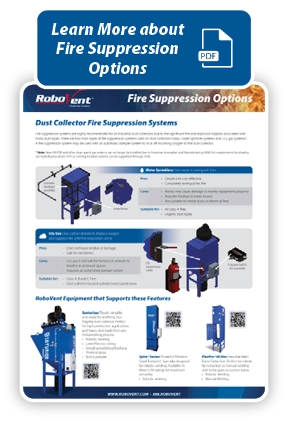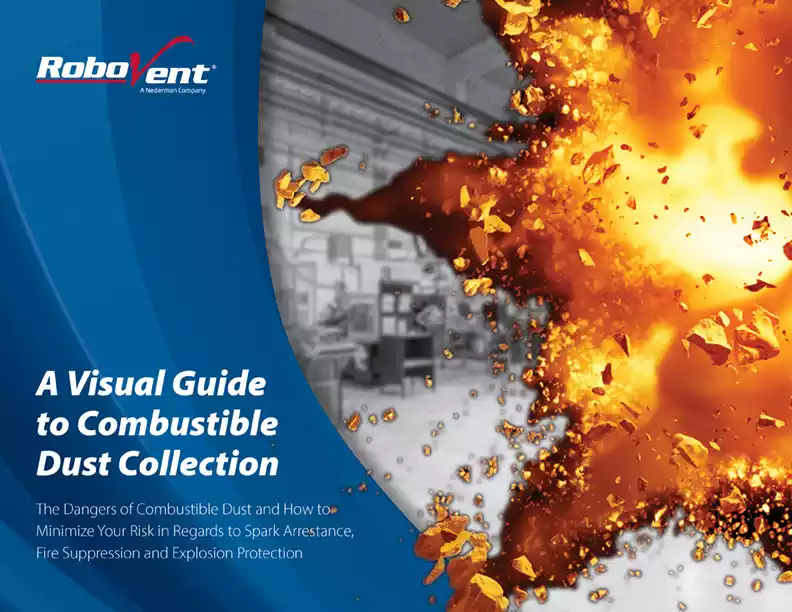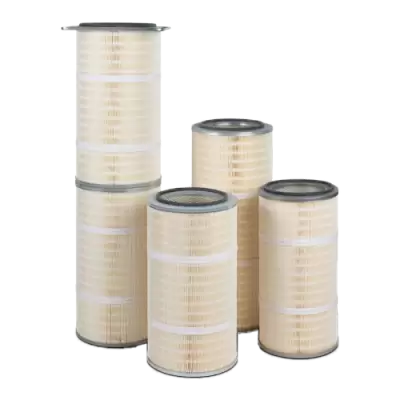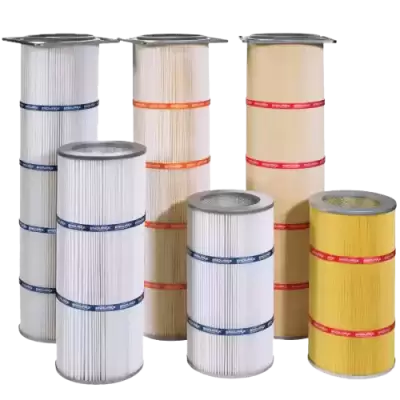Grounding and Bonding for Dust Collection Systems
Static electricity can be a significant ignition risk for facilities handling combustible dust. Bonding and grounding of dust collection systems are critical safety measures that prevent the accumulation of static charges inside the dust collector and ductwork. Proper bonding and grounding are essential to reduce the risk of a combustible dust explosion and remain compliant with relevant safety standards.
Static Hazards in Dust Collection
Static electricity is a major hazard in dust collection systems, particularly in environments where combustible dust is present. As dust particles move through ductwork and equipment, they can generate static charges. These charges can also build as the material is milled, transported via conveyor belt, unloaded from bulk bags or trucks, or otherwise disturbed during transport, processing and conveying. If these charges are not properly accounted for and dissipated through bonding and grounding to the earth, they can accumulate on non-conductive surfaces or poorly connected metal parts. This buildup of static electricity can eventually discharge in the form of a spark or static surge, which, in an environment filled with suspended combustible dust, can ignite a dust cloud and cause a conflagration. Industries like food processing, pharmaceuticals, metalworking, and chemical manufacturing are especially prone to these risks because they often handle fine powders or dust that is highly combustible and prone to static charges.
Bonding vs. Grounding: What's the Difference?
Bonding and grounding are both crucial for dissipating static electricity in dust collection systems, but they serve different purposes.
- Bonding involves connecting all conductive parts of a system so they share the same electrical potential, preventing dangerous static discharges as material transfers between components. It ensures that no part of the system has a differing charge.
- Grounding provides a safe pathway for static electricity to discharge into the earth, neutralizing any electrical energy that builds up in the system.
When combined, bonding and grounding work together to eliminate static charges that could otherwise accumulate and discharge, potentially igniting combustible dust. Both are essential for preventing dust explosions and ensuring system safety, especially in hazardous industrial environments. Without bonding, parts of the system could become isolated from one another, and without grounding, the static charge wouldn't have a safe path to dissipate, increasing the risk of ignition. Therefore, they are imperative and required safety measures that must be implemented together for optimal protection.
Regulations and Standards for Dust Collector Bonding and Grounding
Several key regulations and standards apply to bonding and grounding for dust collectors to ensure safety. These standards ensure safe operation and reduce the risk of dust explosions caused by static discharge. Some important ones to know include:
- NFPA 70 (National Electric Code): Covers proper component construction, bonding methods, and operational requirements for electrical systems, among other aspects of electrical safety.
- NFPA 77 (Static Electricity): Provides guidelines for controlling static electricity, including bonding and grounding requirements for dust collection systems.
- NFPA 654 (Combustible Dust): Covers the prevention of fire and dust explosions, specifying bonding and grounding practices for dust collection equipment.
- OSHA 29 CFR 1910.307: Outlines requirements for hazardous locations, including proper grounding practices in combustible dust environments.
- IEC/ATEX (Europe): These directives specify safety requirements for equipment, including grounding in explosive atmospheres.
How to Bond the Dust Collector and Dust Collection System
Bonding ensures that all conductive parts of a dust collection system have the same electrical potential, preventing dangerous energy accumulations between components. Here's how to bond a system effectively.
- Identify all conductive parts: This includes metal ductwork, the dust collector housing, filters, hoppers, drums, and any other metallic parts.
- Use conductive materials: Ensure that all components are made of conductive materials, such as metal, that can transmit static charges.
- Connect all parts with conductive mechanisms: Use bonding mechanisms (straps, wires, metal clasps, connected supports, internal bonding coils, etc.) to connect each conductive component, ensuring a continuous electrical connection throughout the entire system. The bonding mechanisms should be clamped or bolted securely to avoid loose connections. When non-metallic components are used, they should be bridged with bonding straps to maintain electrical continuity.
- Inspect for paint or coatings: Painted surfaces or non-conductive coatings can interfere with bonding. Ensure that the bonding straps or wires are connected to bare metal for proper conductivity.
- Test with an ohmmeter: After installation, test the bonding connections using an ohmmeter to verify that there is negligible resistance between bonded components.
How to Ground the Dust Collector
Grounding is a critical step in preventing static electricity buildup in a dust collection system, which can pose a significant risk of fire or explosion in facilities handling combustible dust. While bonding ensures that all conductive components maintain the same electrical potential, grounding provides a safe path for static charges to dissipate into the earth. Here's how to ground your system effectively.
- Install a Grounding Rod: Insert a metal grounding rod into the earth near the dust collection system. The rod should be at least 8 feet deep to ensure proper grounding and at a distance from the building to ensure that it does not interfere with lightning protection.
- Attach Grounding Wires: Connect grounding wires from all conductive parts (e.g., the dust collector housing, ductwork, filters) to the grounding rod. Use clamps to secure connections.
- Verify Ground Continuity: After installation, use an ohmmeter to test the resistance between the grounded parts and the rod. The resistance should be negligible, ensuring proper grounding. The ground rod’s resistance to earth should be approximately 25 ohms in accordance with NFPA 780.
Installation of the grounding rod and wires is usually best left to a qualified electrician or engineering firm.
Filter Considerations
When considering dust collector cartridge filters in relation to static electricity, both filter selection and proper bonding and grounding are crucial.
- Filter Selection: For combustible dusts, filters made of static-dissipating materials, such as conductive or semi-conductive media, may be recommended. Common choices include carbon-impregnated or aluminized filters that help dissipate static.
- Filter Bonding: Each filter must be properly bonded to the dust collection system to prevent static buildup. This often involves ensuring that filter cages or clamps maintain electrical continuity.
- Grounding: Filters must be grounded as part of the overall system, allowing any static charge generated by dust movement to dissipate safely into the earth.
Ductwork Considerations
When designing ductwork for dust collection systems, considerations for material and grounding are critical to prevent static electricity buildup within the duct system.
- Material Selection: Conductive materials like metal (steel or aluminum) are preferred for ductwork. Non-conductive materials, such as PVC, are discouraged by NFPA 654 and NFPA 77 because they can accumulate static charges and can be unable to be bonded to connected ducts and equipment, posing a higher explosion risk. ATEX Directives in Europe specify similar requirements.
- Bonding and Grounding: Ducts must be bonded to ensure electrical continuity and grounded to safely dissipate static charges. If the system uses flexible hoses, make sure these hoses are designed with internal bonding coils or conductive liners; alternatively, external bonding wires or straps can be used in accordance with NFPA 70 and 77. These should be connected properly at both ends, ensuring contact with metal components.
- Design Layout: Ensure continuous grounding throughout the duct system, with minimal breaks. When using sight glasses or non-metallic sections, bonding straps should bridge these gaps to maintain grounding.
Verification and Maintenance
 Regular maintenance and verification are essential for ensuring that bonding and grounding systems remain effective in dust collection equipment. Over time, system components like ductwork, filters and connections can degrade due to vibrations, corrosion or wear, leading to loose or broken connections that compromise static discharge safety.
Regular maintenance and verification are essential for ensuring that bonding and grounding systems remain effective in dust collection equipment. Over time, system components like ductwork, filters and connections can degrade due to vibrations, corrosion or wear, leading to loose or broken connections that compromise static discharge safety.
Scheduled preventive maintenance (PM) intervals are the perfect time for facilities to inspect, test and repair any faulty connections, ensuring that bonding and grounding systems continue to function as intended. Verifying grounding continuity through tools like ohmmeters also ensures that electrical resistance is within safe limits.
Additional Explosion Mitigation Strategies
 Bonding and grounding for dust collection equipment are an important part of a comprehensive explosion mitigation plan. When working with combustible materials, bonding and grounding must be used in tandem with additional mitigation strategies outlined in OSHA, NFPA and ATEX regulations or standards. These strategies must be tailored to the hazard level of the dust (e.g., explosive potential and minimum ignition energy) and other identified hazards in the facility. In facilities handling combustible dust, a Dust Hazard Analysis (DHA) must be conducted, per NFPA 654, to identify hazards and mitigation recommendations. Some additional deflagration prevention and protection methods may include:
Bonding and grounding for dust collection equipment are an important part of a comprehensive explosion mitigation plan. When working with combustible materials, bonding and grounding must be used in tandem with additional mitigation strategies outlined in OSHA, NFPA and ATEX regulations or standards. These strategies must be tailored to the hazard level of the dust (e.g., explosive potential and minimum ignition energy) and other identified hazards in the facility. In facilities handling combustible dust, a Dust Hazard Analysis (DHA) must be conducted, per NFPA 654, to identify hazards and mitigation recommendations. Some additional deflagration prevention and protection methods may include:
- Deflagration/Explosion Mitigation Systems: These include explosion vents, suppression systems, and isolation valves, which help manage or contain an explosion if one occurs.
- Inerting: In especially high-hazard environments (e.g., when working with materials with low minimum ignition energy and high explosive potential), it may be recommended to introduce inert gases (like nitrogen) to reduce the oxygen concentrations below the level where a spark or flame can be produced with the specific material(s) handled, in order to minimize the likelihood of a combustion reaction.
- Human Static Discharge: Workers in high-risk environments can generate static electricity, requiring the use of Electrostatic Discharge (ESD) mats, wrist straps, or conductive footwear to prevent discharge
To learn more about explosion mitigation, download our Visual Guide to Combustible Dust.

Questions About Dust Collector Bonding and Grounding?
Working with qualified electricians or an engineering firm for bonding and grounding is advisable to ensure the safety and compliance of your dust collection system. These professionals are experienced in understanding electrical systems, static risks, and the specific needs of industrial environments. They can properly install, test, and verify bonding and grounding connections, ensuring that the system adheres to NFPA standards and local regulations.
At RoboVent, we ensure all our dust collection system installations are equipped with proper bonding and grounding techniques to prevent static discharge and maintain safe operations. Our commitment to safety is reflected in our adherence to industry standards like NFPA, ensuring your facility is protected from dust explosion hazards. If you have any questions about your dust collector's safety, or need guidance on bonding and grounding, our team is here to help.
Contact our safety experts for advice.
Contact Us With Your Questions!
SUBSCRIBE TO
BLOG UPDATES











